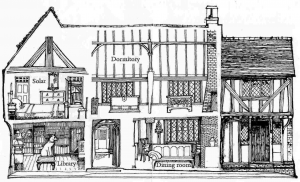Lavenham and the Cloth Trade
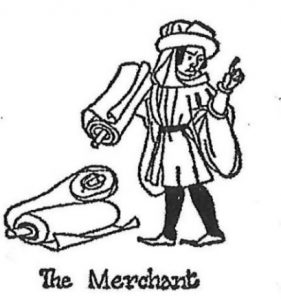
The Clothier, Clothmaker, Clothman, Merchant – are all terms used for the man who grew rich on profits of the ‘putting out’ system of manufacture of the cloth industry in the 14th,15th and the first half of the 16th century. The clothier was able to employ and organise a team of out-workers, often working in their own homes or sometimes his own premises. The richest in Lavenham at this time being Thomas Spring 2 and Thomas Spring 3.
The Clothier came from many different backgrounds; he may have been a successful worker in one of the many stages of cloth working such as a weaver, dyer, fuller etc; or he may have formerly been a woolman, the ‘middle man’ negotiating the purchase of fleece between the Clothier and the supplier. He could have also begun his commercial life as a general merchant, acquiring experience, expertise, good trade contacts and in particular a trusted reputation, which could be put to good use in the marketing and sale of the cloth. Some clothiers were people of enormous landed wealth, using their land for fulling mills, dying apparatus and warehouses as well as general farming.
With the development of the export trade of finished cloth to overseas markets, the industry required more organisation.
The Clothier used his ability to trade on credit to buy in more fleeces and organise teams of workers, controlling the production from start to finish. He built a fine ‘open hall house’ where he could do business. This was regularly updated and embellished with ornamental carvings to indicate his growing wealth. Most of the best still survive in Lavenham today. Little Hall is a good example
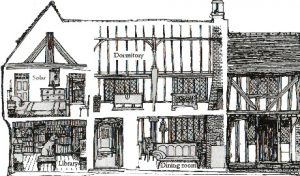
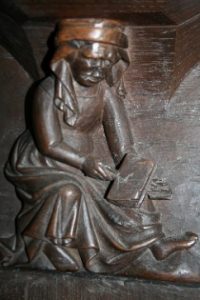
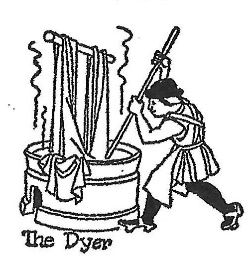
The Clothier was a busy man. He used a ‘woolman’ to source the fleece who would be able to travel and make purchases on his behalf. There were a variety of suppliers to be found at the big Wool Fairs, for example Stourbridge in Cambridgeshire was a very large and popular one. The abbeys had vast flocks and would have fleeces to sell here as well as at other fairs and markets across the country. The fact that the Clothier had built up a reputation and was known to be trustworthy meant the deal could often be conducted on credit.
When the sacks of fleeces arrived, they needed to be stored correctly, as a fleece will deteriorate and lose its volume over a period of time. Therefore, the timing of transactions would be crucial.
The process of turning fleece into cloth begins with sorting the wool – long and short, dirty and clean, soft and rough, light and dark – and weighing it. It has to be combed or carded depending on its length and suitability. It is then spun into yarn, this process generally carried out by ladies, ‘spinsters’ in their own homes.
The picture shows a Lady carding wool, from the Miserichord at Norton Church
Dyeing can be done in various ways, either ‘in the wool’, i.e. before it is spun, or ‘in the yarn’, after it is spun. The dyer would require his premises to be near a constant supply of water and need an assortment of vats, cisterns and vessels. Lavenham became well known for its ‘Lavenham Blews’ and this colour was obtained from the leaf of woad. In the early days this plant was not grown in England and had to be imported from Toulouse and Spain.
Local carpenters would build the loom ready for Weaving. There were laws which limited how many looms could be in one place, so a clothier may well have had them sited in several places.
Lavenham was well known for its broadcloth which is approximately two metres wide and 28 metres long, although there were other sizes such as a ‘narrow’ half a broadcloth, and ‘strait’ quarter of a broadcloth.
After weaving, the cloth was washed by the fuller who would also need a ready source of water. This process is two-fold, first to get rid of the oils and fats in the cloth and secondly to thicken it, making it denser. In Roman times we know this process was done by treading the cloth in a mixture of water and urine in a large pit. In later times fulling mills were developed where the cloth was beaten by large wooden hammers instead of treading with the feet. The cloth was then put out to dry on long wooden frames known as ‘tenters’ which were placed in the open air either in a field or on a windy hill. These frames had small nails on the top and bottom of the frame in order that the cloth could be pulled back into shape. We get the expression ‘on tenter hooks’ from this operation. During the drying process the cloth was ‘teased’ to enhance the density using teasel heads nailed into hand held frames.
The Shearer was the man who finished the cloth ready for market. He handled the large length of cloth over a flat board, checking it and shearing the pile with a large pair of hand-held shears. Then he would tidy up any loose ends, press, fold and bale it.
Now ready for sale, the clothier would present it to the local Alnager who would levy a tax. It is from some rare survivors of Alnage reports of the 15c, that we can gain some interesting information relevant to the production of cloth for Lavenham.
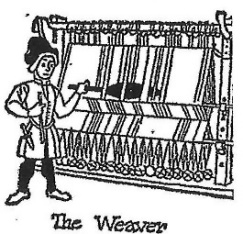
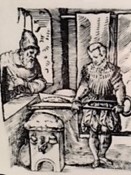
The responsibility of transporting the finished product to market now rested with the clothier. During the 14c and 15c this would go via the ports at Ipswich or Colchester direct to merchants abroad. However, towards the end of the 15th century, the Hanseatic League took more control, setting up their markets in the Blackwell Hall in Leadenhall Street, London.
Getting the cloth to London posed more difficulties for the clothier. The roads were just poorly maintained earth tracks and the journey from Lavenham would have taken three or four days. In surviving wills of the time, we see clothiers leaving money for the reparation of track ways. The other way to London would be to take the cloth by cart to the ports and then sail it to London on the barges.
By detailing the processes and logistics involved at every stage, it can be seen what a busy man the Clothier would be, controlling every part of business. Today we would call it a ‘cottage industry’ or ‘artisan’. Not all clothiers worked to equal capacity so that output varied considerably, which can be seen from the tantalising list of Alnage accounts available for 1424 – 5 and 1468 – 9 relating to Lavenham,
From the remarkable prosperity of the 14th and 15th century and into the first half of the 16th century changes gradually took hold. New, more modern materials, such as cottons and linens were brought into Britain by the Flemish weavers and the Italian clothiers. Demand grew for these lighter, more fashionable fabrics. The bigger towns of Norwich, Colchester and Cambridge were able to adapt to more up to date methods of manufacture but smaller towns such as Lavenham lost out. Cloth was still manufactured in Lavenham on a smaller scale but it had lost the leadership it had enjoyed for some 300 years past.
What became of the Clothier then? He did not stay around where no big money was to be made and the working Clothiers and Merchants left the area to make their fortunes elsewhere.
However, we also find that on the back of the wealth generated by their predecessors, some have risen in society, acquired or built grander houses in the countryside and are living new lives as a gentlemen or landowners.
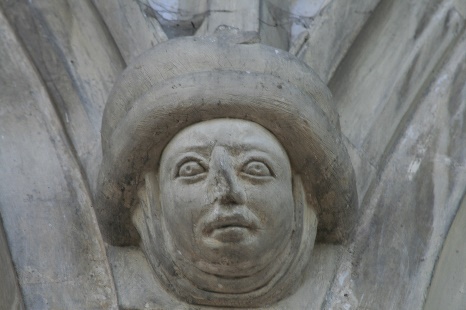
A carving of a merchant or clothier from Clare Church
Information prepared for Little Hall by Dinah James MITGA
